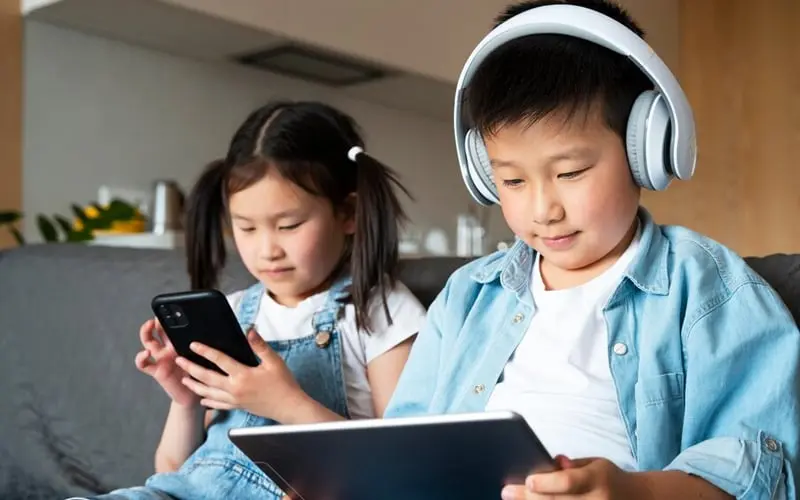Introduction:
In today’s digital age, smartphones are an integral part of life. While phones offer numerous benefits, including educational apps, entertainment, and communication tools, they can also pose risks if not used appropriately, especially for children. As parents, it’s crucial to ensure that kids are using their phones safely, responsibly, and in a way that supports their well-being. Here’s a comprehensive guide on how to use a phone for children, balancing the benefits and potential pitfalls.
1. Understand the Age Appropriateness:
The first step in determining how to introduce a smartphone to your child is understanding the for them to have one. Experts suggest the following:
- Under 5 years old: At this age, children should not be using smartphones or tablets for extended periods. If digital devices are used, they should be limited to educational apps with active involvement from a parent or guardian.
- Ages 6-12: Children may start using phones for educational apps, games, and video chats with family members. A basic phone or a child-friendly smartphone with limited internet access might be appropriate.
- Teens (13+): Adolescents may have a more independent phone experience. However, parents should still monitor their usage to ensure safe and balanced screen time.
2. Set Clear Boundaries and Rules:
Children need clear rules to follow when using a phone. Setting boundaries ensures that kids understand when and how much screen time is appropriate. Here are a few things to consider:
- Screen Time Limits: According to the American Academy of Pediatrics (AAP), children aged 2-5 should get no more than 1 hour of screen time per day. For older kids, balancing screen time with other activities like outdoor play, reading, and family time is essential.
- Usage Times: Establish “no-phone zones,” such as during meals or before bed, to help your child focus on family interactions or winding down at night. Make sure that screen time doesn’t interfere with sleep hygiene.
- App Permissions: Limit the apps your child can install. Use built-in parental controls or third-party apps to restrict access to age-inappropriate content, games, or social media.
3. Use Parental Controls and Monitoring Tools:
Smartphones come with various parental controls to help limit screen time, block inappropriate content, and monitor activity. Here’s how to make the most of these features:
- Google Family Link (Android): This app allows parents to set digital ground rules for their children’s devices. You can track your child’s phone usage, manage app downloads, set screen time limits, and monitor their location in real-time.
- Apple Screen Time (iOS): Screen Time is a built-in feature that lets parents set limits on apps, restrict content, and monitor how much time is spent on various apps. Parents can also schedule “downtime” for their child’s phone, ensuring there’s time for other activities.
- Third-Party Apps: Apps like Qustodio, Norton Family, and Kaspersky Safe Kids offer more comprehensive monitoring features, including activity reports, location tracking, and web filtering.
4. Teach Responsible Use of Social Media and Communication Apps:
As children grow older, they may begin to explore social media and messaging apps. This is where open communication is key. Teaching kids how to navigate these platforms safely is essential for protecting them from online dangers.
- Discuss Online Privacy: Teach your child about privacy settings, the importance of protecting personal information, and the risks of sharing sensitive data.
- Monitor Social Interactions: Encourage kids to keep you informed about who they’re talking to and what they’re posting online. Set guidelines for who they can communicate with and what type of content is appropriate to share.
- Be Aware of Cyberbullying: Make sure your child knows how to identify cyberbullying and how to report inappropriate behaviour to you or the platform administrators. Let them know that they can always come to you with concerns.
5. Encourage Balance and Healthy Habits:
Excessive screen time can lead to various issues, including poor posture, sleep disturbances, and mental health concerns like anxiety and depression. It’s important to model healthy phone use and encourage balanced habits:
- Promote Physical Activity: Encourage your child to spend time outdoors and engage in physical activities that don’t involve screens. Outdoor play is crucial for developing social skills, creativity, and physical health.
- Model Good Phone Behaviour: Children often model behaviour based on what they see. If you’re constantly glued to your phone, your child will likely mirror that behaviour. Set a positive example by using your phone mindfully and showing your child how to balance screen time with real-life interactions.
- Digital Detox: Schedule regular “phone-free” days or periods, especially on weekends or during family outings. This encourages children to engage with the world around them instead of always being tied to a screen.
6. Select Educational and Fun Apps:
Smartphones can be a great educational tool if you select the right apps. Instead of simply handing over the phone for entertainment purposes, introduce your child to apps that can foster learning and creativity.
- For Younger Children: Apps like Endless Alphabet, PBS Kids Games, and Montessori 123 can introduce concepts such as numbers, letters, shapes, and critical thinking.
- For Older Kids and Teens: Apps like Duolingo for language learning, Khan Academy for free educational courses, and Tinkercad for learning 3D design are great ways to combine fun with education.
- For Creative Expression: Encourage your child to use apps like GarageBand (for music creation), Procreate Pocket (for digital art), or Stop Motion Studio (for creating stop-motion animation).
7. Lead by Example:
Children learn a lot by observing how their parents and caregivers use phones. As a parent, it’s essential to model healthy technology habits:
- Create Tech-Free Zones: Set aside times when the family disconnects from devices, such as family dinners or weekends at the park. This allows for more meaningful interactions without the distraction of screens.
- Be Present: When spending time with your child, try to be present and engaged. Avoid checking your phone constantly during one-on-one time, as this can send the message that phone use is more important than quality time with them.
8. Stay Informed and Adapt:
Technology is constantly evolving, and it’s important for parents to stay informed about new apps, social media platforms, and potential risks. Stay updated on the latest trends and have regular conversations with your child about their phone usage and experiences. Be flexible and willing to adapt rules as your child grows and their needs change.
Conclusion: Creating a Balanced Approach:
Phones are not inherently harmful for children, but without the right boundaries, guidance, and tools, they can become a source of distraction, exposure to inappropriate content, or even negative social influences. By setting clear rules, using parental controls, and encouraging healthy phone habits, you can help your child develop a responsible and balanced relationship with their device. The key is open communication, parental involvement, and regular reassessment of how technology fits into your child’s life.
By setting the right foundation early, children can enjoy the many benefits that smartphones offer, such as education, communication, and creativity, while avoiding the pitfalls that can arise from excessive or unsafe usage.

